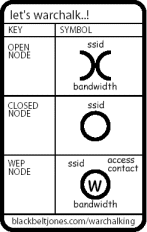Warchalking
The name refers to chalk symbols that indicate to those in the know that an unsecured wireless networking station is nearby that can be used to tap into a corporate network and get illicit free Internet access. The term and the code were created by Matt Jones in the UK, based on the symbols that tramps and hobos once chalked on walls and doors to pass on information to others about houses to avoid or where a meal was to be had. Within days of appearing on his web site, the idea had been picked up by SlashDot in the USA and his symbols had been seen in London, New York, and Seattle.

This is just the most recent of a set of terms which is threatening to turn war into a geek prefix meaning something like “attempting to gain unauthorised network access”. The first was the 1980s term war dialling for the way that hackers systematically dialled telephone numbers in search of a modem that might give them network access. More recent examples include war driving (driving around with a portable computer, looking for unsecured wireless networks) and warwalking (the same idea, but on foot). In a sign of its vitality, warchalking has already given rise to the parody terms chalkchalking, pubchalking, and blogchalking and it is being seriously suggested that the symbols should also mark legitimate access points.
Warchalking’s rise to infamy has even been given an air of governmental legitimacy, at least in the US: the state of Utah is planning on using the warchalking symbols on 250 government buildings.
Guardian, July 2002
Whether it be a coffee shop in Seattle, a chip shop in Newcastle or an airport lounge in Hong Kong, any place that offers free wireless access to attract customers should be encouraged to adopt the conventions of warchalking to specify its network capabilities.
Personal Computer World, Sep. 2002
